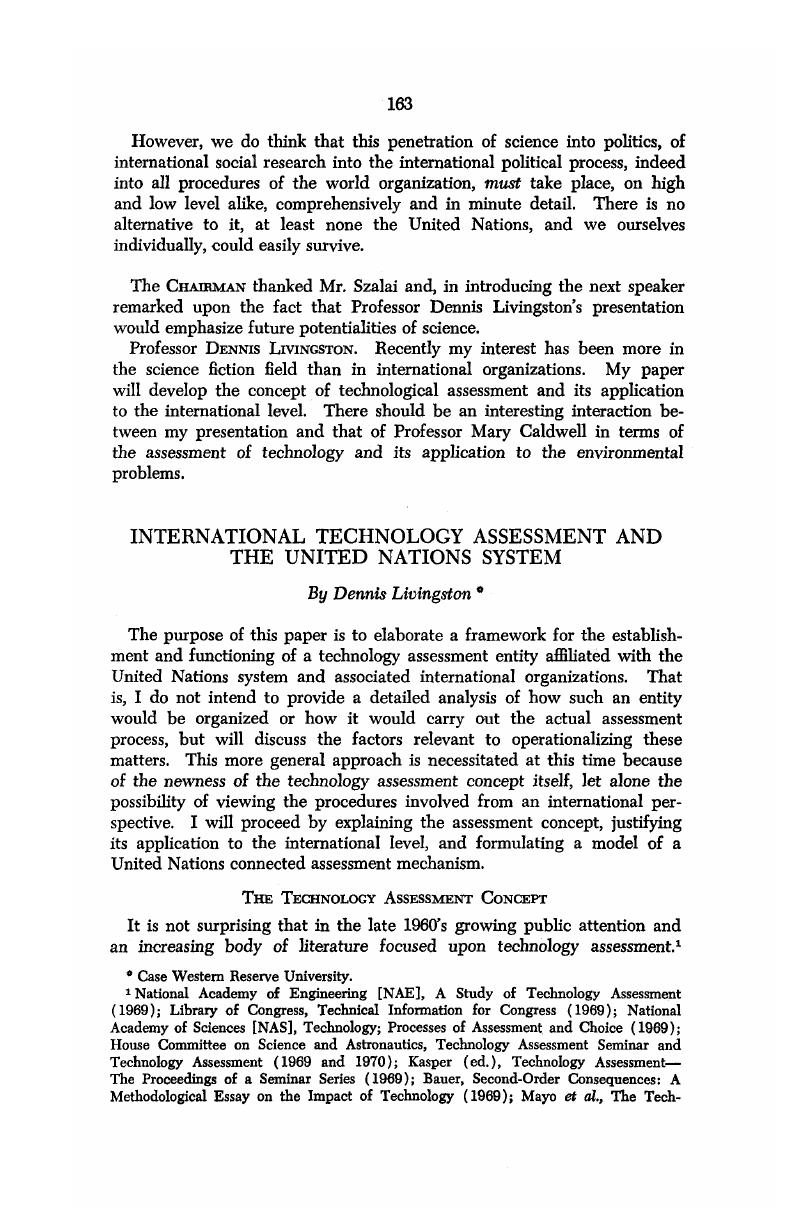Article contents
International Technology Assessment and the United Nations System
Published online by Cambridge University Press: 28 March 2017
Abstract

- Type
- Panel: The United Nations and Science
- Information
- Copyright
- Copyright © American Society of International Law 1970
References
1 National Academy of Engineering [NAE], A Study of Technology Assessment (1969); Library of Congress, Technical Information for Congress (1969); National Academy of Sciences [NAS], Technology; Processes of Assessment and Choice (1969); House Committee on Science and Astronautics, Technology Assessment Seminar and Technology Assessment (1969 and 1970); Kasper (ed.), Technology Assessment— The Proceedings of a Seminar Series (1969); Bauer, Second-Order Consequences: A Methodological Essay on the Impact of Technology (1969); Mayo, et al., The Technology Assessment Function (3 parts) (1968)Google Scholar; Wheeler, , “Bringing Science Under Law,” 2 The Center Magazine 56 (1969)Google Scholar; Wormuth, “Government and Science,” 3 ibid. 41 (1970); Lear, , “Predicting the Consequences of Technology,” 53 Saturday Review 44 (1970)Google Scholar.
2 NAE, op. cit. 1.
3 Kranzberg, “Historical Aspects of Technology Assessment,” in House Committee on Science and Astronautics, Technology Assessment, op. ctt. 380-388.
4 Katz, “Statement,” and Daddario, “The Four Faces of Technology Assessment,” ibid. 173-183 and 376-380.
5 NAS, op. cit. vii-viii, 72-114; NAE, op. cit. 30-36.
6 Lear, loc. cit. 44; New York Times, March 25, 1970, p. 23.
7 Livingston, , “Pollution Control: An International Perspective,” 10 Environment 172 (1968)Google Scholar; Wolman, , “Pollution as an International Issue,” 47 Foreign Affairs 164 (1968)10.2307/20039362CrossRefGoogle Scholar; U.N. Secretary General, Problems of the Human Environment (1969); Kennan, , “To Prevent a World Wasteland: A Proposal,” 48 Foreign Affairs 401 (1970)10.2307/20039452CrossRefGoogle Scholar.
8 Mayo, op. cit. Part I, pp. 3-4; House Committee on Government Operations, Scientific Brain Drain from the Developing Countries (1968); Caryl P. Haskins, The Scientific Revolution and World Politics 17-46 (1964).
9 NAE, op. cit. 25-34.
10 NAS, op. cit. 90-94.
11 House Committee on Science and Astronautics, Earth Resources Satellite System (1969); R. E. Hallgren, , “The World Weather Program,” 8 TRW Space Log 2 (1968)Google Scholar.
12 Bauer (ed.), Social Indicators (1966); Gross (ed.), Social Intelligence for America’s Future: Explorations in Societal Problems (1969).
13 Ayres, Technological Forecasting and Long-Range Planning (1969); Jantsch, Technological Forecasting in Perspective (1967).
14 Senate Committee on Aeronautical and Space Sciences, International Cooperation and Organization for Outer Space 390-399 (1965).
- 3
- Cited by




